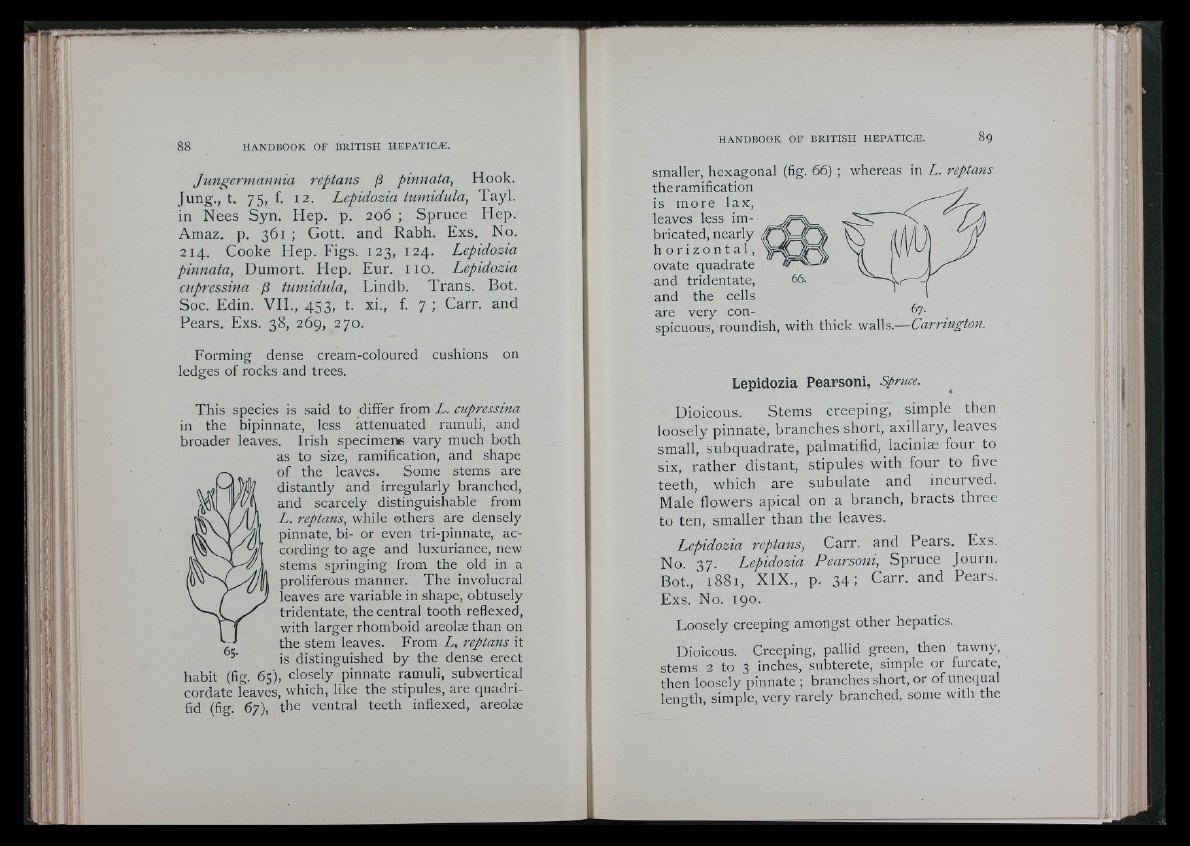
It'
Jungermannia reptans j3 pinnata, Hook.
Jung., t. 75, f. 12. Lepidozia tumidula, Ta y l .
in Nees S yn . Hep. p. 206 ; Sp ru c e Hep.
Ama z . p. 361 ; Gott. and Rabh. Exs. No.
214. Co o ke Hep. Figs. 123, 124. Lepidozia
pinnata, Dumort. Hep. Eur. 110. Lepidozia
cupressina ¡3 tumidula, Lindb. Trans . Bot.
Soc. Edin. V IE , 453, t. xi., f. 7 ; Carr, and
Pears. Exs. 38, 269, 270.
Forming dense cream-coloured cushions on
ledges of rocks and trees.
This species is said to differ from L. cupressina
in the bipinnate, less attenuated ramuli, and
broader leaves. Irish specimenis vary much both
as to size, ramification, and shape
of the leaves. Some stems are
distantly and irregularly branched,
and scarcely distinguishable from
L. reptans, while others are densely
pinnate, bi- or even tri-pinnate, according
to age and luxuriance, new
stems springing from the old in a
proliferous manner. The involucral
leaves are variable in shape, obtusely
tridentate, the central tooth reflexed,
with larger rhomboid areolæ than on
the stem leaves. From Z. reptans it
is distinguished by the dense erect
habit (fig. 65), closely pinnate ramuli, subvertical
cordate leaves, which, like the stipules, are quadrifid
(fig. 67), the ventral teeth inflexed, areolæ
smaller, hexagonal (fig. 66) ; whereas in L. reptans
the ramification
is mo r e lax,
leaves less imbricated,
nearly
h o r i z o n t a l ,
ovate quadrate
and tridentate,
and the cells
are very conspicuous,
roundish, with thick walls.— Carrington.
Lepidozia Pearsoni, Spruce.
Dioicous. S tems creeping, simple then
loosely pinnate, branches short, axillary, leaves
small, subquadrate, palmatifid, laciniæ four to
six, rather distant, st ipules with four to five
teeth, which are subulate and incurved.
Male flowers apical on a branch, bracts three
to ten, smaller than the leaves.
Lepidozia reptans, Carr, and Pears. Exs.
No. 37. Lepidozia Pearsoni, Sp ru c e Journ.
Bot., 1881, X IX . , p. 3 4 ; Car r , and Pears.
Exs. No. 190.
Loosely creeping amongst other hepatics.
Dioicous. Creeping, pallid green, then tawny,
stems 2 to 3 inches, subterete, simple or furcate,
then loo.sely pinnate ; branches short, or of unequal
length, simple, very rarely branched, some with the